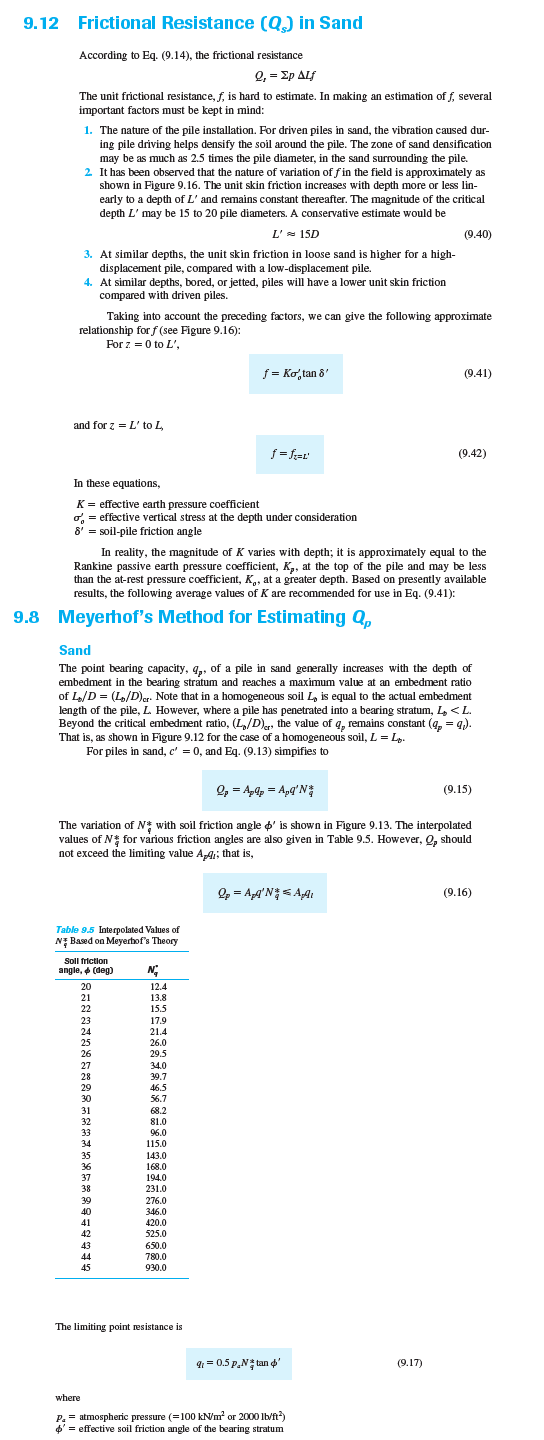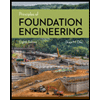A driven closed-ended pile, circular in cross section, is shown in Figure P9.4. Calculate the following. a. The ultimate point load using Meyerhof's procedure. d. The ultimate frictional resistance Q,- [Use Eqs. (9.40) through (9.42), and take K = 1.4 and 8' = 0.64'.] e. The allowable load of the pile (use FS = 4). Y -15.7 KN/m = 32 Groundwater Yu - 18.2 AN/m = 32 Yu- 19.2 KN/m - 40 15 m
A driven closed-ended pile, circular in cross section, is shown in Figure P9.4. Calculate the following. a. The ultimate point load using Meyerhof's procedure. d. The ultimate frictional resistance Q,- [Use Eqs. (9.40) through (9.42), and take K = 1.4 and 8' = 0.64'.] e. The allowable load of the pile (use FS = 4). Y -15.7 KN/m = 32 Groundwater Yu - 18.2 AN/m = 32 Yu- 19.2 KN/m - 40 15 m
Fundamentals of Geotechnical Engineering (MindTap Course List)
5th Edition
ISBN:9781305635180
Author:Braja M. Das, Nagaratnam Sivakugan
Publisher:Braja M. Das, Nagaratnam Sivakugan
Chapter18: Pile Foundation
Section: Chapter Questions
Problem 18.7P
Related questions
Question

Transcribed Image Text:9.12
Frictional Resistance (Q) in Sand
According to Eq. (9.14), the frictional resistance
0, = Ep ALf
The unit frictional resistance, f, is hard to estimate. In making an estimation of f, several
important factors must be kept in mind:
1. The nature of the pile installation. For driven piles in sand, the vibration caused dur-
ing pile driving helps densify the soil around the pile. The zone of sand densification
may be as much as 2.5 times the pile diameter, in the sand surrounding the pile.
2 It has been observed that the nature of variation of fin the field is approximately as
shown in Figure 9.16. The unit skin friction increases with depth more or less lin-
early to a depth of L' and remains constant thereafter. The magnitude of the critical
depth L' may be 15 to 20 pile diameters. A conservative estimate would be
L' 15D
(9.40)
3. At similar depths, the unit skin friction in loose sand is higher for a high-
displacement pile, compared with a low-displacement pile.
4. At similar depths, bored, or jetted, piles will have a lower unit skin friction
compared with driven piles.
Taking into account the preceding factors, we can give the following approximate
relationship for f (see Figure 9.16):
For z = 0 to L',
f = Ko, tan 8
(9.41)
and for z = L' to L,
f = f=r
(9.42)
In these equations,
K= effective earth pressure coefficient
o, = effective vertical stress at the depth under consideration
8' = soil-pile friction angle
In reality, the magnitude of K varies with depth; it is approximately equal to the
Rankine passive earth pressure coefficient, K,, at the top of the pile and may be less
than the at-rest pressure coefficient, K,, at a greater depth. Based on presently available
results, the following average values of K are recommended for use in Eq. (9.41):
9.8 Meyerhof's Method for Estimating Q,
Sand
The point bearing capacity, q,, of a pile in sand generally increases with the depth of
embedment in the bearing stratum and reaches a maximum value at an embedment ratio
L/D = (L/D),r. Note that in a homogeneous soil L, is equal to the actual embedment
length of the pile, L. However, where a pile has penetrated into a bearing stratum, L, <L
Beyond the critical embedment ratio, (L/D)., the value of q, remains constant (q, = q).
That is, as shown in Figure 9.12 for the case of a homogeneous soil, L = L,.
For piles in sand, c' = 0, and Eq. (9.13) simpifies to
0, = A,4, = A,q'N
(9.15)
The variation of N* with soil friction angle o' is shown in Figure 9.13. The interpolated
values of N for various friction angles are also given in Table 9.5. However, Q, should
not exceed the limiting value Agi; that is,
(9.16)
Table 9.5 Interpolated Values of
N; Based on Meyerhof's Theory
Soll friction
angle, (deg)
N
20
12.4
21
13.8
22
15.5
23
17.9
24
21.4
25
26.0
26
29.5
27
34.0
28
39.7
29
46.5
30
56.7
31
.
68.2
32
81.0
33
96.0
34
115.0
35
143.0
36
168.0
37
194.0
38
231.0
39
276.0
40
346.0
41
420.0
525.0
42
43
650.0
44
780.0
45
930.0
The limiting point resistance is
4 = 0.5 p,N tan d'
(9.17)
where
P. = atmospheric pressure (=100 kN/m? or 2000 Ib/n)
4' = effective soil friction angle of the bearing stratum
![A driven closed-ended pile, circular in cross section, is shown in Figure P9.4.
Calculate the following.
a. The ultimate point load using Meyerhof's procedure.
d. The ultimate frictional resistance Q,. [Use Eqs. (9.40) through (9.42), and take
K = 1.4 and 8' = 0.64'.]
e. The allowable load of the pile (use FS = 4).
Y - 15.7 kN/m
= 32
Groundwater
table
Yu - 18.2 kN/m³
d= 32
Yu - 19.2 kN/m³
= 40
15 m
381 mm
Figure P9.4](/v2/_next/image?url=https%3A%2F%2Fcontent.bartleby.com%2Fqna-images%2Fquestion%2F8e622b37-0e5c-4ab5-9ccb-6e092754143b%2Fdb0ce6f9-6a92-4246-878c-a89a03cc7bd6%2Fvf37cqn_processed.png&w=3840&q=75)
Transcribed Image Text:A driven closed-ended pile, circular in cross section, is shown in Figure P9.4.
Calculate the following.
a. The ultimate point load using Meyerhof's procedure.
d. The ultimate frictional resistance Q,. [Use Eqs. (9.40) through (9.42), and take
K = 1.4 and 8' = 0.64'.]
e. The allowable load of the pile (use FS = 4).
Y - 15.7 kN/m
= 32
Groundwater
table
Yu - 18.2 kN/m³
d= 32
Yu - 19.2 kN/m³
= 40
15 m
381 mm
Figure P9.4
Expert Solution
This question has been solved!
Explore an expertly crafted, step-by-step solution for a thorough understanding of key concepts.
This is a popular solution!
Trending now
This is a popular solution!
Step by step
Solved in 3 steps

Knowledge Booster
Learn more about
Need a deep-dive on the concept behind this application? Look no further. Learn more about this topic, civil-engineering and related others by exploring similar questions and additional content below.Recommended textbooks for you

Fundamentals of Geotechnical Engineering (MindTap…
Civil Engineering
ISBN:
9781305635180
Author:
Braja M. Das, Nagaratnam Sivakugan
Publisher:
Cengage Learning

Principles of Foundation Engineering (MindTap Cou…
Civil Engineering
ISBN:
9781337705028
Author:
Braja M. Das, Nagaratnam Sivakugan
Publisher:
Cengage Learning

Principles of Foundation Engineering (MindTap Cou…
Civil Engineering
ISBN:
9781305081550
Author:
Braja M. Das
Publisher:
Cengage Learning

Fundamentals of Geotechnical Engineering (MindTap…
Civil Engineering
ISBN:
9781305635180
Author:
Braja M. Das, Nagaratnam Sivakugan
Publisher:
Cengage Learning

Principles of Foundation Engineering (MindTap Cou…
Civil Engineering
ISBN:
9781337705028
Author:
Braja M. Das, Nagaratnam Sivakugan
Publisher:
Cengage Learning

Principles of Foundation Engineering (MindTap Cou…
Civil Engineering
ISBN:
9781305081550
Author:
Braja M. Das
Publisher:
Cengage Learning